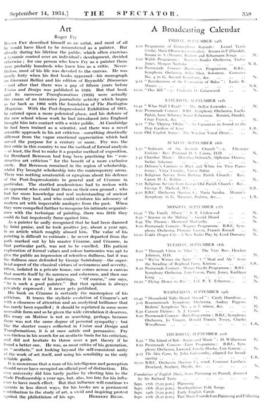Art
Roger Fry
ROGER Fay described himself as an artist, and most of all he would have liked to be remembered as a painter. But already during his lifetime the public, which often exercises a tyrannic control over an individual's development, decided otherwise ; for one person who knew Fry as a painter there were probably hundreds who knew him as a critic. Never- theless, most of his life was devoted to the canvas. He was nearly forty when his first books appeared-his monograph on Giovanni Bellini and his edition of Reynolds' Discourses -and after that there was a gap of fifteen years before Vision and Design was published in 1920. But that book and its successor Transformations (1920 were actually the cream of an intensive journalistic activity which began as far back as 1903 with the foundation of The Burlington Magazine. With the Post-Impressionist Exhibition of 1911, he entered upon a more polemical phase, and his defence of the new school whose work he had introduced into England brought him into contact with a wider public. At Cambridge he had been trained as a scientist, and there was a novel scientific approach in his art criticism-something drastically different from the vague emotional appreciation which had served the purpose for a century or more. Fry was the first critic in this country to use the method of formal analysis -at least, the first to make it a popular method of exposition, for Bernhard Berenson had long been practising his " con- structive art criticism " for the benefit of a more exclusive circle. But Berenson remained in the region of scholarship, whilst Fry "brought scholarship into the contemporary arena. There was nothing amateurish or egregious about his defence of the Post-Impressionists in general and of Cezanne in particular. The startled academicians had to reckon with an opponent who could beat them on their own ground ; who had far more knowledge and real understanding of ancient art than they had, and who could reinforce his advocacy of modern art with impeccable analogies from the past. When they were compelled further to recognize his intimate acquaint- ance with the technique of painting, there was little they could do but impotently fume against him.
As a painter he sadly recognized that he had been damned by faint praise, and he took positive joy, about a year ago, in an article which roughly abused him. The value of his painting is difficult to estimate ; he never departed fiom the path marked out by his master Cezanne, and Cezanne, in that particular path, was not to be excelled. His patient exploration of formal values and colour harmonies was apt to give the public an impression of relentless dullness, but it was the dullness once defended by George Saintsbury-the super- ficial aspect of the classical virtues of seriousness and severity. Often, isolated in a private house, one comes across a canvas that asserts itself by its sureness and coherence, and then one discovers it is one of his paintings. " Of course," one says, he is such a good painter." But that opinion is always privately expressed ; it never gets published.
His book on Cezanne is certainly the masterpiece of his criticism. It traces the stylistic evolution of Cezanne's art with a closeness of attention and an analytical brilliance that has rarely been equalled ; it should be reprinted in some more accessible form and so be given the wide circulation it deserves. His essay on Matisse is not so searching, perhaps because there was not the same degree of personal sympathy ; but like the shorter essays collected in Vision and Design and Transformations, it is at once subtle and persuasive. Fry was tireless in his search for an aesthetic basis for his criticism, and did not hesitate to throw over a pet theory if he found a better one. He was, as most critics of his generation, an aesthete," not looking beyond the self-consistent unity of the work of art itself, and using his sensibility as the only reliable, guide.
It is monstrous that a man of his intelligence and perception should never have occupied an official post of distinction. His own university did him tardy justice by electing him to the Slade Professorship a year ago, but, alas, too late for his influ- ence to haVe much effect. Mit that influence will continue to Operate in less direct ways, for his books are a permanent contribution to the study of art, a vivid and inspiring protest
against the Philistinism of his age. HERBERT READ.










































 Previous page
Previous page